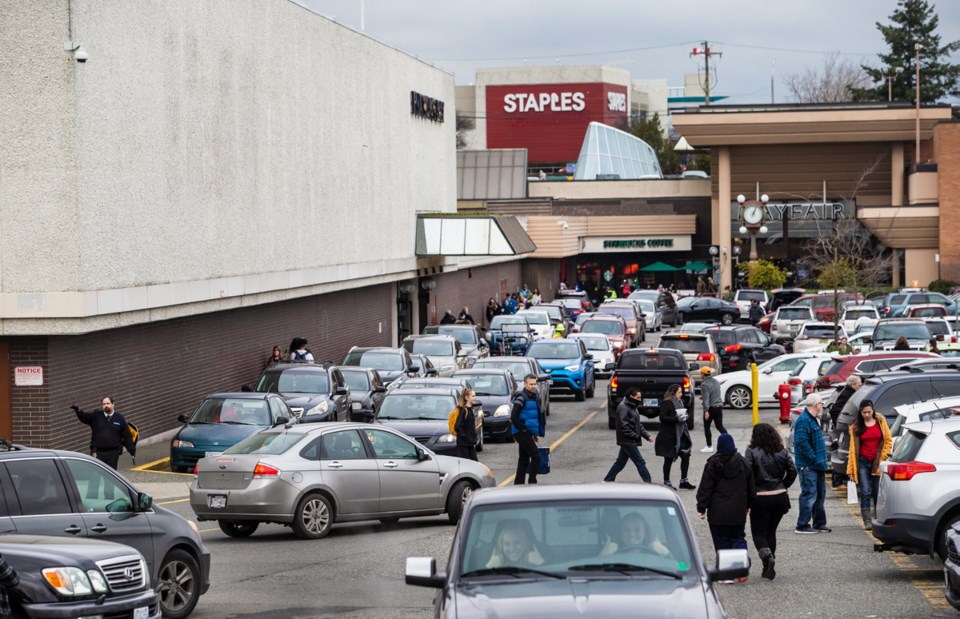If you were trying to get to the Tsawwassen ferry terminal or the Vancouver International Airport or find parking at Mayfair shopping centre on Dec. 26, you might doubt Canada’s most recent retail sales numbers.
On one of the busiest travel days of the season, the approach to the ferry causeway slowed to a crawl due to the numbers of people heading not to the ferries, but to the Tsawassan Mills mall on Highway 17, near the terminal. Cheryl from De Courcy Island reported that even merging onto Highway 17 from Highway 17A by Ladner was difficult because of volume of mall-bound traffic.
People trying to catch flights from the Vancouver airport found the bridges and roads to Sea Island clogged with shoppers driving to McArthurGlen Designer Outlet mall east of the airport. The mall reported it expected 50,000 shoppers on Boxing Day — more than triple the number it sees on a weekend.
Here in Victoria, Mayfair mall’s parking lot overflowed, and local resident Scott reported heavy, slow traffic on Blanshard for blocks north of the mall. “I turned around. There’s nothing I’m so desperate to buy that I need to put myself through that.”
Contrast those scenes of shopping frenzy with Statistics Canada’s mid-December release of retail sales numbers. The federal agency reported a 1.2 per cent decrease in sales across Canada for October, more than one-half per cent lower than had been forecast. It was the second consecutive month the overall numbers had declined. In September, Canadian retailers sold 0.1 per cent fewer goods in the month as consumers spent less on motor vehicles and gasoline. Excluding motor vehicles, retail sales climbed 0.2 per cent.
Retail sales measure the change in the total value of inflation-adjusted sales at the retail level. The metric is the foremost indicator of consumer spending, which accounts for the majority of overall economic activity.
The irony is that the numbers StatsCan released in December date from the last period before the pre-holiday shopping rush begins. The Christmas shopping push doesn’t ramp up until Nov. 1, when the Halloween window displays switch to images of Ho-Ho-Holiday cheer. The Black Friday-Cyber Monday combo sees sales jump in Canada, but nothing to rival U.S. numbers. For many Canadian bricks-and-mortar stores, Boxing Day continues to reign supreme as the year’s busiest sales day.
But we won’t see the official tally of December’s retail numbers until February. Economists may be celebrating a reversal of those worrying fall numbers at about the time when the cold, hard, harsh reality of our holiday frivolity hits home in our pocketbooks. By that time, we’ll have received the last of our credit-card bills. After the season of excess comes the season of gruel, drippings, cheese rinds and lentils.
There’s a reason Lent comes after Advent.
Another irony is that those depressed October sales numbers date from the latest results of the MNP Debt Index. The IPSOS survey found that nearly half of Canadians are $200 or less away from financial insolvency. Of these, 29 per cent are insolvent at month’s end.
The survey also found that, on average, after they’d paid all their bills and debt obligations, Canadians were left with just $557 at the end of the month. That is the lowest level of month-end savings since 2016.
Men, millennials and Gen-Zs saw the biggest hits.
According to a Google report, these three demographic groups are most likely to wait until the height of the holiday season to prepare for the season, thereby most likely to pay more.
Despite that — despite last year’s well- and often-reported increases in household debt levels — the survey indicates Canadians feel more assured about their finances and their ability to cope financially with life’s surprises than they did in 2018. For example, 40 per cent of respondents rated their personal debt situation as “excellent,” and only 16 per cent rated it as “terrible.” Almost half indicated they’re confident they’ll be debt-free in retirement.
Whether you think those views well-founded or utterly naïve, that optimism fuelled the highway queues to Tsawwassen Mills, McArthurGlen Designer Outlet and Mayfair shopping centre on Boxing Day.



